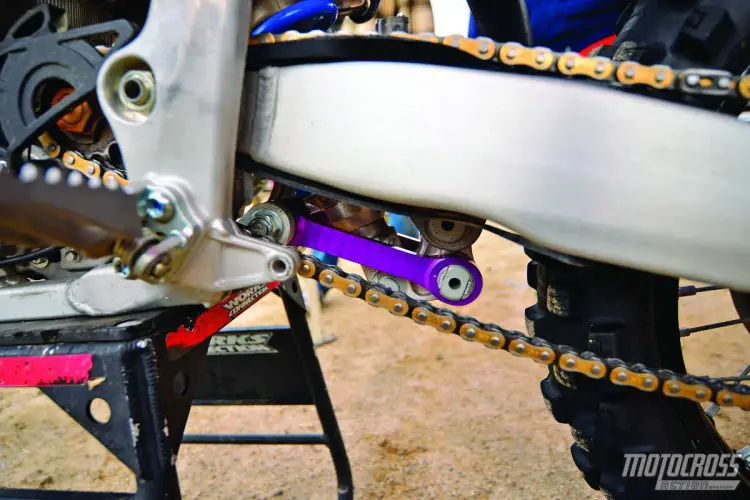MXA TEAM TESTED: JGRMX ADJUSTABLE YZ250/450F SHOCK LINKAGE
WHAT IS IT? The JGRMX YZ250/450F adjustable shock linkage system not only lowers the rear of 2010–’15 YZ450Fs and 2013–’15 YZ250Fs, it also stiffens the rear of the YZ-F’s Kayaba shock during its initial movement. What is original about the JGR YZ450F linkage is that it is adjustable, allowing the rider to choose how low he wants to go.
WHAT’S IT COST? $279.99.
CONTACT? www.jgrmx.com or (877) 905-4769.
WHAT STANDS OUT? Here’s a list of things that stand out with the JGR adjustable YZ450F link.
(1) Function. The rising-rate linkage on your bike makes it possible to manipulate the suspension curve to put more or less leverage on the shock by increasing the speed of the shock as the rear wheel moves through its arc. Got that? It does this by changing the amount of shaft travel per increment of rear-wheel travel. The linkage ratio makes the shock’s valving work more effectively when the situation calls for a stiffer response. With plentiful leverage in the beginning of the stroke, the suspension will feel softer in the first part of the travel. Conversely, late in the shock’s stroke, when there is more shaft travel for the same amount of rear-wheel travel, the shock naturally gets firmer.
(2) Design consideration. It is important to note that a complete rising rate system consists of a bell crank (that the shock attaches to) and a linkage arm (that positions the bell crank in relationship to the frame). Motorcycle manufacturers are constantly changing their rising rates by changing the eccentric cam shape of the bell crank; however, adding longer or shorter linkage arms does not actually change the rising rate as much as it changes the starting point of where the rising rate starts on the bell crank. JGR’s adjustable linkage arm enables a rider to increase the length of the link from the stock 142mm to 146mm (in 1mm increments). As the length of the linkage arm is increased, the rear of the bike gets lower because the bell crank and the shock attached to it are rotated down. By moving the bell crank’s eccentric cam, the starting point of the rising rate is moved into a stiffer point of the curve. This makes the bike slightly stiffer during its initial movement to help lessen wallowing.
(3) Installation. The JGR adjustable linkage mounts like any other aftermarket linkage, with the exception of the snap-in inserts that go in the rear-link bolt holes. These inserted bolt holes are drilled at different lengths to make the arm go from the stock length to 4mm longer. As for lowering the rear of the bike, 1mm shorter will lower it 8mm; 2mm will lower it 14mm; 3mm will lower it 19mm; and 4mm will lower it 23mm.
(4) Performance. The MXA wrecking crew loves longer links on the YZ450F—not only because the bike rides too high in the rear, but because a little extra stiffness helps control sudden movements of the rear shock. Most test riders ran it at 2mm longer, but short riders went with 3mm. Most MXA test riders consider a longer link to be a handling product instead of a suspension product. By lowering the rear of the YZ450F, you lessen its irritating stinkbug stance, and as the bike gets lower, its cornering ability improves noticeably.
WHAT’S THE SQUAWK? You can’t just bolt the JGR link on and forget it. You will need to lighten the low-speed compression two clicks (the shock will feel stiffer the longer the link is), reset the sag and raise the forks up in the clamps to reset the balance of the chassis. The goal is to get the bike flat.









Comments are closed.